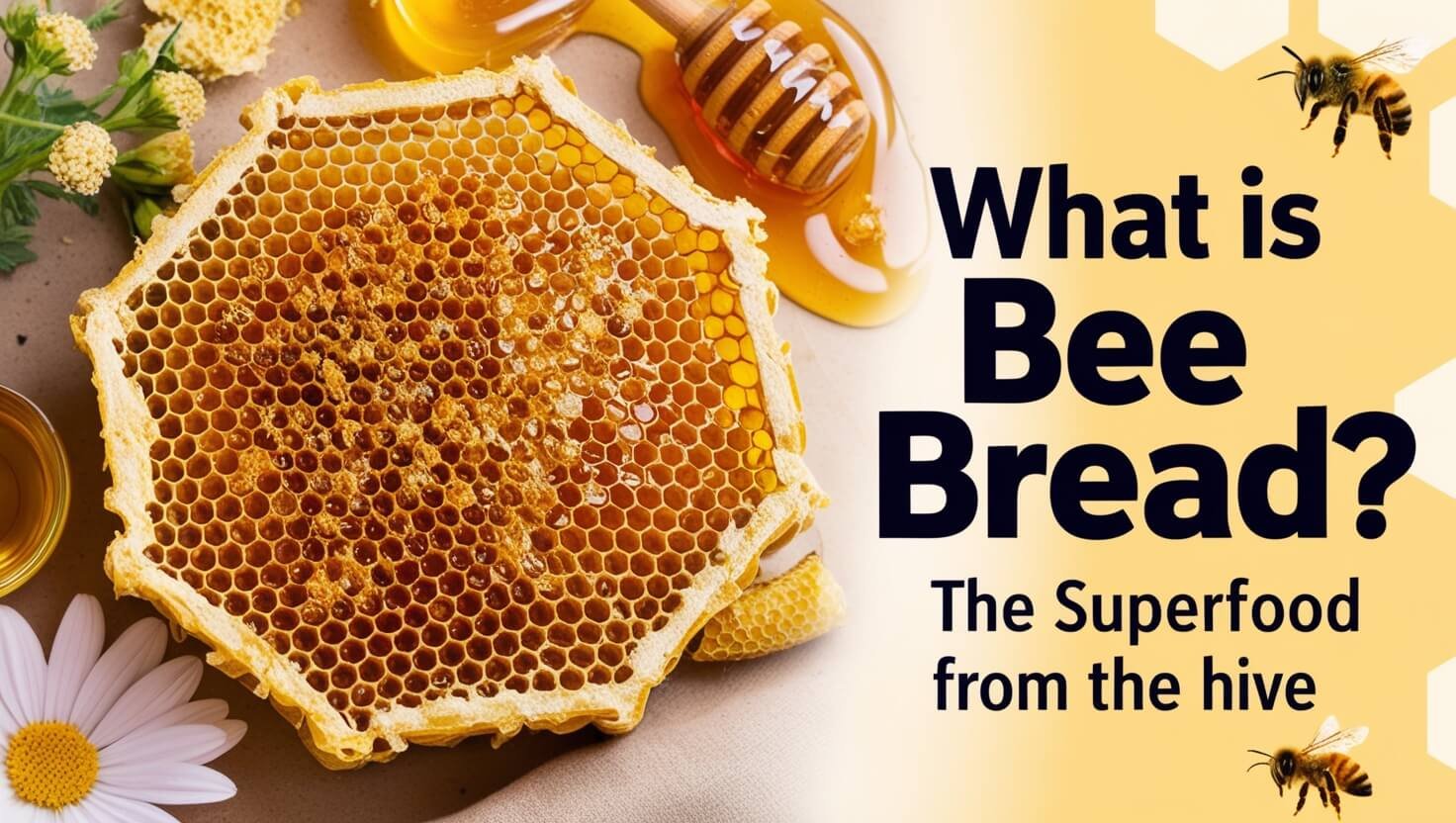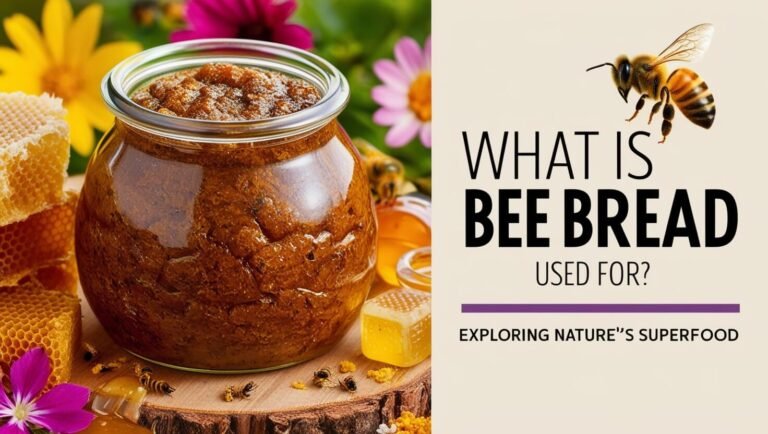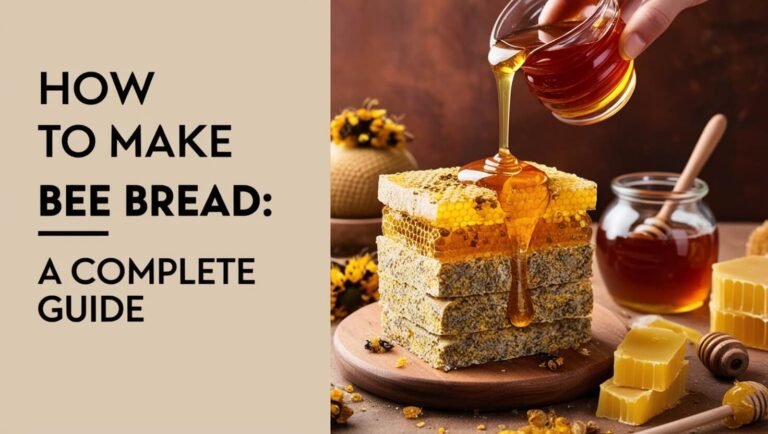What is Bee Bread? The Superfood from the Hive

Bee bread is a remarkable superfood that has been gaining attention in the health and wellness community. But what exactly is this mysterious substance, and why is it creating such a buzz? In this comprehensive guide, we’ll explore the world of bee bread, from its origins to its potential health benefits and everything in between.
Definition and Origin
Bee bread is a fermented mixture of bee pollen, honey, and bee saliva that worker bees create as a primary source of food for the hive. This nutrient-dense substance has been used by bees for millions of years and has recently caught the attention of humans for its potential health benefits.
How Bees Create Bee Bread
The process of creating bee bread is a testament to the incredible organization and efficiency of bee colonies. Worker bees collect pollen from flowers and mix it with nectar and enzymes from their saliva. This mixture is then packed into honeycomb cells and left to ferment, resulting in the creation of bee bread.
The Composition of Bee Bread
To truly understand the value of bee bread, it’s essential to delve into its composition and how it differs from other bee-related products.
Nutritional Profile
Bee bread is a nutritional powerhouse, containing a wide array of essential nutrients:
- Proteins: Including all essential amino acids
- Carbohydrates: Primarily simple sugars for quick energy
- Lipids: Healthy fats and fatty acids
- Vitamins: B-complex vitamins, vitamins A, C, D, and E
- Minerals: Iron, calcium, magnesium, zinc, and selenium
- Enzymes: Important for digestion and metabolism
- Antioxidants: Including flavonoids and carotenoids
This diverse nutritional profile makes bee bread a true superfood, offering a wide range of potential health benefits.
Differences Between Bee Bread and Bee Pollen
While bee bread and bee pollen are related, they are not the same thing. Bee pollen is the raw material collected by bees from flowers, while bee bread is the fermented product created within the hive. The fermentation process enhances the nutritional value and bioavailability of the nutrients, making bee bread potentially more beneficial than raw bee pollen.
The Fascinating Process of Making Bee Bread
Understanding how bees create bee bread gives us a deeper appreciation for this natural superfood and the incredible insects that produce it.
Pollen Collection by Bees
The process begins with worker bees visiting flowers to collect pollen. They use their legs to gather the pollen and pack it into special structures called pollen baskets or corbiculae. During this collection process, the bees mix the pollen with nectar and enzymes from their saliva, beginning the transformation from raw pollen to bee bread.
Fermentation in the Hive
Once the pollen mixture is brought back to the hive, it’s packed tightly into honeycomb cells. The bees then seal these cells with a thin layer of honey and wax. This environment, combined with the enzymes already present in the mixture, initiates a fermentation process.
During fermentation, which typically lasts several weeks, the following changes occur:
- Lactic acid bacteria break down complex sugars into simpler forms
- The pH of the mixture decreases, creating an environment that inhibits the growth of harmful microorganisms
- Enzymes continue to break down complex nutrients into more easily digestible forms
- The overall nutrient profile is enhanced, with increased levels of certain vitamins and antioxidants
This fermentation process is crucial, as it not only preserves the bee bread for long-term storage but also significantly increases its nutritional value and digestibility.
Health Benefits of Bee Bread
The unique composition of bee bread contributes to its numerous potential health benefits. While more research is needed to fully understand its effects on human health, preliminary studies and traditional use suggest several promising advantages.
Boosting Immune System
Bee bread is rich in antioxidants, vitamins, and minerals that play crucial roles in supporting immune function. The high levels of vitamin C, zinc, and flavonoids may help strengthen the body’s natural defenses against infections and diseases.
Supporting Digestive Health
The fermentation process that creates bee bread produces beneficial bacteria and enzymes that can support digestive health. These probiotics may help maintain a healthy gut microbiome, potentially improving digestion and nutrient absorption.
Enhancing Energy Levels
The combination of simple carbohydrates, B-vitamins, and iron in bee bread may contribute to improved energy levels and reduced fatigue. This makes it a popular choice among athletes and those looking for a natural energy boost.
Potential Allergy Relief
Interestingly, some people have reported that regular consumption of bee bread has helped alleviate their seasonal allergies. The theory is that exposure to small amounts of pollen in bee bread may help desensitize the immune system to allergens over time. However, more research is needed to confirm this effect.
Antioxidant Properties
Bee bread is packed with antioxidants, including flavonoids and phenolic compounds. These substances help protect cells from oxidative stress and may reduce the risk of chronic diseases associated with inflammation and cellular damage.
How to Use Bee Bread
Incorporating bee bread into your diet can be both easy and delicious. Here are some tips on how to use this superfood effectively.
Recommended Dosage
As with any supplement, it’s important to start with a small amount of bee bread and gradually increase your intake. A typical recommended dosage is 1-2 teaspoons per day for adults. However, it’s always best to consult with a healthcare professional before adding any new supplement to your diet, especially if you have allergies or are taking medications.
Adding Bee Bread to Your Diet
There are many ways to incorporate bee bread into your daily routine:
- Eat it raw: Simply take a spoonful of bee bread as a quick snack or supplement.
- Mix it into yogurt or smoothies: Add a teaspoon to your morning yogurt or blend it into a smoothie for an extra nutritional boost.
- Sprinkle on salads: Use bee bread as a nutrient-rich topping for salads.
- Spread on toast: Mix bee bread with a little honey to create a nutritious spread for toast or crackers.
Bee Bread Recipes
Get creative with bee bread by trying these simple recipes:
- Bee Bread Energy Balls
- Mix 1 cup of dates, 1/2 cup of almonds, 2 tablespoons of bee bread, and 1 tablespoon of coconut oil in a food processor.
- Roll the mixture into small balls and refrigerate for a quick, healthy snack.
- Bee Bread Smoothie
- Blend 1 banana, 1 cup of almond milk, 1 tablespoon of bee bread, 1 teaspoon of honey, and a handful of spinach for a nutritious breakfast smoothie.
- Bee Bread Overnight Oats
- In a jar, combine 1/2 cup of oats, 1/2 cup of milk, 1 tablespoon of bee bread, 1 teaspoon of honey, and a handful of berries.
- Refrigerate overnight and enjoy a ready-made breakfast in the morning.
Sourcing and Storing Bee Bread
To get the most benefit from bee bread, it’s crucial to source high-quality products and store them properly.
Where to Buy Quality Bee Bread
Look for bee bread from reputable sources such as:
- Local beekeepers: Often the best source for fresh, high-quality bee bread.
- Health food stores: Many specialty health stores carry bee bread products.
- Online retailers: Ensure they have good reviews and clear information about their sourcing practices.
When purchasing bee bread, look for products that are:
- Raw and unprocessed
- Free from additives or preservatives
- Sourced from areas with low pollution and pesticide use
Proper Storage Techniques
To maintain the quality and nutritional value of bee bread:
- Store in an airtight container to protect from moisture and contaminants.
- Keep in a cool, dark place away from direct sunlight.
- Refrigerate or freeze for long-term storage to preserve freshness and nutritional content.
- Use within 6-12 months for optimal quality, though properly stored bee bread can last longer.
Potential Side Effects and Precautions
While bee bread is generally considered safe for most people, there are some potential risks and considerations to keep in mind.
Allergic Reactions
Individuals with pollen allergies or bee product sensitivities should exercise caution when consuming bee bread. Allergic reactions can range from mild symptoms like itching or hives to severe reactions such as anaphylaxis. It’s crucial to start with a very small amount and monitor for any adverse reactions.
Interactions with Medications
Bee bread may interact with certain medications due to its complex composition. For example:
- Blood thinners: The vitamin K content in bee bread might interfere with blood-thinning medications.
- Antibiotics: The probiotics in bee bread could potentially interact with antibiotic treatments.
Always consult with a healthcare provider before adding bee bread to your diet, especially if you’re taking medications or have existing health conditions.
Bee Bread in Traditional Medicine
The use of bee bread in traditional medicine practices offers fascinating insights into its potential health benefits.
Historical Uses
Bee bread has been used in traditional medicine systems for centuries, particularly in Eastern Europe and Asia. Historical uses include:
- Boosting overall vitality and energy
- Supporting liver health
- Enhancing fertility and reproductive health
- Improving skin conditions
- Aiding in recovery from illness or surgery
Modern Applications
While many traditional uses of bee bread are still being scientifically validated, modern applications often focus on its nutritional density and potential health-promoting properties. Current areas of interest include:
- Sports nutrition: As a natural energy and recovery supplement for athletes
- Immune support: Particularly during cold and flu seasons
- Stress management: Due to its rich B-vitamin content
- Anti-aging: For its antioxidant properties and potential skin benefits
As research continues, we may discover even more applications for this remarkable substance in modern health and wellness practices.
Bee Bread vs. Other Bee Products
To fully appreciate bee bread, it’s helpful to understand how it compares to other popular bee products.
Comparing Bee Bread to Honey
While both bee bread and honey are produced by bees, they differ significantly in composition and nutritional profile:
- Nutrient density: Bee bread is generally more nutrient-dense, containing higher levels of proteins, vitamins, and minerals.
- Sugar content: Honey is primarily composed of simple sugars, while bee bread has a more complex nutritional profile.
- Probiotic content: Bee bread contains beneficial bacteria due to fermentation, which is not present in honey.
- Caloric content: Honey is higher in calories due to its high sugar content.
Both products have their unique benefits, with honey being valued for its antibacterial properties and natural sweetness, while bee bread is prized for its nutritional complexity.
Bee Bread and Royal Jelly
Royal jelly is another bee product often compared to bee bread:
- Production: Royal jelly is produced by worker bees specifically to feed queen bees and larvae, while bee bread is a staple food for worker bees.
- Composition: Royal jelly is rich in proteins and fatty acids, particularly 10-HDA (10-Hydroxy-2-decenoic acid). Bee bread has a more diverse nutritional profile.
- Availability: Bee bread is more abundant and easier to harvest than royal jelly, which is produced in smaller quantities.
- Uses: Both are used as nutritional supplements, but royal jelly is often marketed for its potential anti-aging and beauty benefits.
While both bee bread and royal jelly offer unique health benefits, bee bread is generally more accessible and versatile in its applications.
The Role of Bee Bread in Beekeeping
Understanding the importance of bee bread in beekeeping provides valuable context for its production and availability.
Importance for Bee Colony Health
Bee bread plays a crucial role in maintaining the health and productivity of bee colonies:
- Nutrition for worker bees: It’s the primary protein source for adult worker bees.
- Larval development: Bee bread is essential for feeding and developing bee larvae.
- Colony strength: Adequate bee bread stores contribute to overall colony strength and resilience.
- Winter survival: Stored bee bread helps colonies survive during winter months when foraging is not possible.
Sustainable Harvesting Practices
Responsible beekeepers must balance the harvesting of bee bread with the needs of the colony:
- Timing: Harvesting is typically done during periods of abundant pollen flow to ensure the colony has sufficient resources.
- Quantity: Only a small portion of the hive’s bee bread stores should be harvested to avoid compromising colony health.
- Hive management: Some beekeepers use special frames or traps to collect bee bread without disturbing the main brood area.
- Supplementation: In some cases, beekeepers may provide pollen substitutes to compensate for harvested bee bread.
These practices ensure that bee bread can be sustainably produced without negatively impacting bee populations.
Bee Bread and Environmental Impact
The production and consumption of bee bread have broader implications for our environment and ecosystems.
Supporting Bee Populations
By creating demand for bee bread, consumers indirectly support beekeeping practices that maintain healthy bee populations:
- Habitat preservation: Beekeepers often work to protect and create bee-friendly habitats.
- Pollination services: Bees used for bee bread production also contribute to pollination of crops and wild plants.
- Awareness: Increased interest in bee products raises public awareness about the importance of bees and their conservation.
Encouraging Biodiversity
The production of high-quality bee bread requires diverse floral sources, which can have positive effects on biodiversity:
- Plant diversity: Beekeepers may plant or protect a variety of flowering plants to ensure diverse pollen sources.
- Ecosystem support: Bees foraging for pollen contribute to the pollination and reproduction of many plant species.
- Sustainable agriculture: The demand for bee bread can encourage farming practices that support pollinator health.
By choosing bee bread and other bee products, consumers can play a role in supporting ecosystems and biodiversity.
Future Research and Potential of Bee Bread
As interest in bee bread grows, so does the potential for new discoveries and applications.
Ongoing Studies
Current research on bee bread is exploring various areas:
- Nutritional analysis: Further detailing the complex composition of bee bread from different floral sources.
- Health benefits: Clinical studies to validate traditional uses and explore new potential benefits.
- Bioavailability: Understanding how the human body absorbs and utilizes the nutrients in bee bread.
- Production methods: Investigating ways to optimize bee bread production without compromising hive health.
Possible Medical Applications
The unique properties of bee bread suggest several potential medical applications that warrant further investigation:
- Natural antibiotic alternatives: The antimicrobial properties of bee bread could be explored for developing new treatments.
- Nutraceuticals: Bee bread might be used to create targeted nutritional supplements for specific health conditions.
- Immunotherapy: The potential role of bee bread in managing allergies could lead to new approaches in allergy treatment.
- Gut health: The probiotic properties of bee bread may have applications in treating digestive disorders.
As research progresses, we may discover even more exciting potential uses for this remarkable substance.
Final Verdict: The Buzz About Bee Bread
Bee bread stands out as a fascinating example of nature’s ingenuity and the incredible capabilities of bees. From its complex nutritional profile to its potential health benefits, bee bread offers a unique opportunity to support both personal wellbeing and environmental health.
As we’ve explored in this comprehensive guide, bee bread is more than just another health food trend. It represents a connection to the natural world, the importance of pollinator health, and the potential for discovering new ways to support human health through natural products.
Whether you’re a health enthusiast, an environmentally conscious consumer, or simply curious about natural remedies, bee bread offers something of interest. As research continues and awareness grows, we can expect to see more innovative uses and applications for this remarkable substance.
By choosing to incorporate bee bread into our lives, we not only potentially benefit our own health but also contribute to a larger ecosystem of sustainable beekeeping and biodiversity support. It’s a small step that can have far-reaching positive impacts.
So, the next time you hear about bee bread, remember that you’re not just hearing about a superfood – you’re learning about a product that represents the interconnectedness of human health, insect behavior, and environmental stewardship. It’s truly something worth buzzing about!




